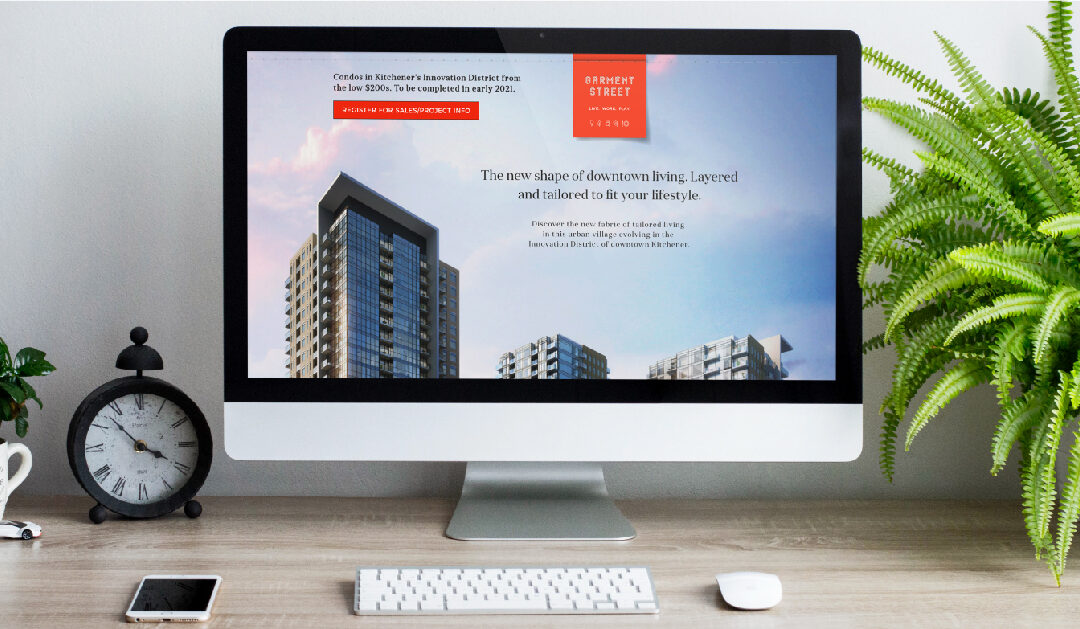
by threshold | Nov 22, 2018 | General
You can have the best apartment marketing ideas in the world, but they won’t help you build any leads if they appear on an outdated desktop-only website.
The idea that mobile is king when it comes to web design isn’t a new concept. Mobile internet usage has been steadily increasing since the late 2000’s. As of January 2018, 56% of global web traffic came from smartphones or tablets.
What does this to do with web design? According to a study from Forrester, mobile-optimized websites have 200-400% higher conversion rates than those that aren’t designed for mobile viewing. Website design can have a significant impact on your business, so let’s explore some key design elements that will help you up your mobile website game.
Design Responsively
If you aren’t already using responsive web design, now’s the time to start. A responsive website uses flexible, fluid layouts to seamlessly resize, rearrange and optimize itself based on the environment and screen size.
Responsive design ensures your website looks good and is readable no matter what device it’s being viewed on. This matters because 38% of people will stop engaging with a website if the content/layout doesn’t display well on their screen.
With responsive websites, you can pour your resources into maintaining only one website as opposed to multiple versions for desktop, smartphone and tablet. Not only does responsive design make viewers happy, it also helps you cut costs. If we look beyond the aesthetics, we find that responsive websites have better SEO rankings because Google prioritizes search results to favor mobile-friendly websites.
Typical methods of rearranging a desktop site design for better viewing on mobile include:
- Converting a multi-column layout to a single column layout
- Changing linear menus to drop-down menus
- Limiting the number of images being displayed (Studies have shown that having fewer images on your mobile site can actually increase conversions.)
- Using collapsible elements like accordions to minimize the amount of information initially presented. Nobody likes a wall of text!
Adopting a cohesive “design language”
Have you ever noticed that a lot of websites seem to have a similar look? The web has an established visual language, and that’s even more apparent on mobile devices due to the crossover with mobile app design. People have expectations for how things should look and feel on the web, and you can leverage this expected “design language” to simplify navigation for your site’s users.
“Design language” sounds like a fancy term, but it just refers to a consistent, cohesive set of rules that your website design should follow. Think of it as a brand guideline for things like buttons, forms, menus, etc.Google’s Material Design is a great example of consistent design language. Let’s consider the issue in the framework of promoting marketing ideas for apartments. A person looking at your property’s registration form should immediately know what it is, how to fill it out, and that the button underneath it is what they need to click on to send it to someone in the leasing office.
Consider how people physically use their mobile devices
The physical limitations of mobile browsing should factor into the design of your website. Keeping text at a legible size is important if you want people to be able to read your content on small screens.
Another, less common thing to consider is the way a mobile user holds their device while browsing on the go. When considering the mobile design of your site, it’s important to remember that only approximately a third of a smartphone’s screen falls into the user’s natural “thumb zone”. Place navigation bars at the bottom of the screen, within this zone, and make sure that CTAs are “above the fold” (the space immediately visible on your phone’s screen when it loads), to minimize scrolling.
There’s a lot to think about when it comes to designing a good mobile website experience. These are just a few of many methods of tailoring your site’s layout and design. At Threshold/Carve, we have a wealth of experience when it comes to creating amazing mobile user experiences that enhance apartment complex marketing ideas. Get in touch to find out more!

by threshold | Nov 8, 2018 | General
Kitchener-Waterloo is one of the fastest growing real estate markets in Ontario. It’s downtown Innovation District is filled with major tech companies and startup hubs — two industries that are a far cry from the textile and garment manufacturing industry that once defined Kitchener-Waterloo.
Garment Street Condos gets its name from the long-forgotten industry that used to power the town. Because of our experience executing strong apartment marketing ideas, Threshold/Carve was asked to develop the marketing and sales strategy for this flagship condo community while promoting the surrounding urban village that was bought and built by the same property development company.
Revealing the Layers of Garment Street
The team dove headfirst into the project to understand the unique aspects of the location, the condos and the building itself. The condo building needed a strong brand to attract both young buyers and real estate investors. We also saw the need for a creative marketing campaign that would promote the surrounding urban village as a “live, work, play” community.
The bottom line behind all our creative marketing efforts was, of course, sales. Our creative would be judged by the number of quality leads that we attracted, all of which would be stored in an online database of VIP Registrants. The creative efforts would culminate in an on-site sales event where leads would be converted into buyers.
The brand naturally grew out of the name, “Garment Street Condos.” Using phrases like “tailored living,” and “a lifestyle that fits,” we evoked the history of Kitchener-Waterloo while encouraging potential buyers to find their home in this evolving neighborhood.
Building the Buyer Database
By introducing these apartment complex marketing ideas to a digital audience, we targeted buyer funnels such as real estate agents, real estate investors and end users. Digital tools like Facebook and AdWords allowed us to reach key buyers and send them to a landing page where leads were captured and a quality buyer database began to take shape.
This database proved to be our most effective marketing tool. The list of potential buyers received targeted emails that helped form the relationship between Garnet Street and the audience. It wasn’t just about sending a reminder email to tell the buyers to come to the sales event; it was about updating the buyers with developments to the community and helping them feel like they were in the loop at all times. That’s how a trusted relationship is built between buyer and property.
When it came time to turn the digital buyer database into real-world sales, Threshold/Carve provided the Garment Street sales team with a sales center designed to extend the brand experience from external media to in-person sales events. This sales center was equipped with sales tools such as brochures, promo-flyers and designed floor plans that helped the sales team convert registrants into buyers.
In the end, Threshold/Carve helped Garment Street gather over 1,200 quality leads in just 3 months. Buyers were lining up at 6 am to participate in the one-night-only sales event, a phenomenon that attracted plenty of extra media attention. Ultimately, the condos sold out within the first hour of the event. That online database turned into hundreds of purchased condos, all thanks to authentic branding and strategic digital marketing ideas for apartments.
Want to generate 1,200 leads for your property? Get in touch with a Threshold/Carve team member today.

by threshold | Oct 25, 2018 | General
With the number of apartments increasing every year, it’s crucial to create a brand that stands out in oversaturated markets. It’s not enough to have the best amenities, or an ideal location, or even the most innovate apartment marketing ideas and materials. Branding is about much more than the physical attributes of a property; it’s about creating a feeling that residents can relate to, latch on to and be attracted to.
Defining a company’s brand is the most critical step of all messaging and marketing plan development strategies. It is the keystone to a much larger strategic plan and, on which, Threshold/Carve places supreme effort to ensure we unearth compelling branding insights.
A property’s brand identity is more than a logo and a tagline. It is how a property differentiates itself from the competition while leaving a lasting positive impression in the minds of prospective residents. To build a new property’s brand, we employ a rigorous brand development process that begins with market research.
As part of this research process, we often fly out to various properties around the country. Once there, we’ll conduct surveys of students to better understand what they are looking for in a new place to live. We tour the competing properties to identify opportunities to differentiate. We immerse ourselves in the surrounding community to understand the market and arm ourselves with the knowledge necessary to develop memorable apartment complex marketing ideas.
We combine this qualitative work with our knowledge of the residential industry to craft a clear brand strategy and differentiating points. Using this knowledge, we create a new brand identity for the property. With the new brand identity as our central point, we create a well-rounded suite of marketing materials to supplement the leasing team with sales pieces including website/landing pages, brochure, flyers and email templates.
These pieces help drive brand awareness, which can ultimately be converted into signed leases.
Threshold/Carve can help you create a brand identity and marketing ideas for apartments that will be sure to stand out against the competition. Get started by to reaching out to a THC team member for advice.

by threshold | Oct 11, 2018 | General
Social media looks a lot different to marketers than it does to the general public. They see memes and messages from their friends. We see targeted ads, trackable statistics and promoted posts disguised as organic content.
It seems like we as a society use social media more than we use all other websites combined. That, plus the fact that social media offers endless tracking and targeting possibilities, explains why social media advertising is such an effective digital marketing method. In the post below, we’ll explain why it’s our favorite vehicle for apartment complex marketing ideas.
Social advertising allows businesses to get their message in front of their ideal customers. They’ll see, hear and remember your brand because it appears on the websites and apps they use most often. Social ads only work, however, if they’re both creative AND strategic.
Any ad can make an impression, but social media targeting tools allow you to make that impression on your ideal audience. Only by combining old school creativity with modern targeting methods and tools can you harness the full power of social media marketing for your apartment marketing ideas.
Every social ad should be three things: targeted, trackable, and flexible.
Targeted because Facebook lets businesses put their ads in front of specific, customized audiences. These audiences can be customized based on their interests, demographic information, location and countless other variables.
Trackable because social media marketing doesn’t end when the ad is created. Businesses should analyze the results by reading through customized reports that show clicks, impressions, and actions taken by their target audience.
Flexible because unlike with most advertising platforms ads, the final version of a social ad doesn’t have to be the final version. Ads can and should change as specials change. If businesses need to boost impressions or lower spend, they can make it happen in real-time.
Once you understand why social ads work so well, you can begin to tweak and test all the different elements of your campaign. Here are three things we’ve learned by experimenting with different methods.
- The most successful ads include special offers. When specials are shown, we’ve seen click-through-rates jump to nearly 3X the industry average. Social media marketing is cutting edge, but it doesn’t take a whiz kid to figure out that people like to feel like they’re getting a good deal.
- Switching from standard Facebook ads to their new carousel ads — which show rotating images — can boost engagement and lower cost per click. When businesses use Facebook’s new advertising tools, Facebook rewards the businesses by giving their ads a higher Ad Relevancy Score.
- Hyper-focused markets lead to successful campaigns. Be sure to target people who might already be inclined to buy your product. For apartment complexes, that means targeting people who might be nearing the end of their current lease.
The tools are out there for you to make your marketing dollars go further. If all this sounds a little daunting, we’re here to help. We’ve been originating digital marketing ideas for apartments for quite some time now, and we’d love to help you figure out how to get the most for your digital marketing dollars. If you’re interested, feel free to reach out to a Threshold/Carve team member today.

by threshold | Sep 20, 2018 | General
What’s the world’s most valuable limited resource? It’s not oil, gold or diamonds, but it’s just as hard to find. We’re talking about people’s attention. Everyone wants it, but nobody has any to spare. In our latest blog about apartment marketing ideas, we’ll explain how you can use social media to capture the attention of your student housing market.
We’ve tested countless student housing ads, and one of the most noticeable insights that jumps out is the fact that imagery captures the attention of student audiences. Specifically, we’re talking about high-quality property images. When it comes to social and display campaigns, it pays to pay for professional images of your property. Videos are even better channels for apartment marketing ideas! Not only do attention-grabbing images and video lower your cost per click and cost per lead, but many of our clients see a jump in website clicks after using video ads.
Some such ads have generated penny clicks and leads as low as $0.50 cents. They’ve also provided a substantial boost to client relevancy scores.
We’re not trying to tell you to ditch static images, but they need to present the property in the best possible light. When you’re developing your apartment complex marketing ideas, think of every image as a potential first impression. High-quality images of furnished apartments capture more people’s attention than pictures of empty rooms.
Some of the top performing campaigns we’ve seen have used such attractive images to generate clicks. These attractive images often include luxurious amenities. We’ve seen impressive ad campaign numbers on ads with poolside pics, especially in our student market. The data tells us that pool shots, grill and patio pics and fitness center imagery performs better than images of interiors. If you are going to show the inside of an apartment, the numbers say to go with shots of the kitchen space and living rooms.
There are numbers that back these strategies, but these apartment marketing ideas also make sense in plain speak. Would you rather see a bedroom or living room decorated as you would do yours upon move-in, or an empty picture of a unit that hasn’t been brightened up or styled? It’s an easy choice.
Image optimization is another major factor with successful campaigns. Having optimized images boosts your ad performance, but you’ve got to know a few effective optimization strategies. Here are some tips:
Watch Your Text
You could see a significant drop in impressions in your Facebook ads if you add too much text to your images. Facebook has adjusted the 20% text-to-image rule, but it’s still very relevant to the performance of your ad. You can check your text-to-image ratio with this text tool.
Make your Message Clear
Be clear with your ad message and make sure your image shows what you’re offering in the text of your post. This helps ensure that the users who click your ad are actually interested in your offer, and it will help you lower the bounce rate on your landing page or website.
Stand Out
As we mentioned above, it’s important to choose images that catch your attention. The average social media user spends roughly 41 minutes a day on each platform, and an average of 3 seconds on each post as they scroll through the newsfeeds. Standing out is the key to getting them to stop scrolling, see your ad and give you their attention.
In conclusion, we have discovered that there is no one-size fits all approach to imagery. It’s important to test all the variables and see what works for your property. It takes time and effort, but the results will help you streamline your marketing efforts and spend your marketing dollars more effectively. If you think you might need some help with your marketing ideas for apartments, feel free to reach out to a THC team member for advice.





